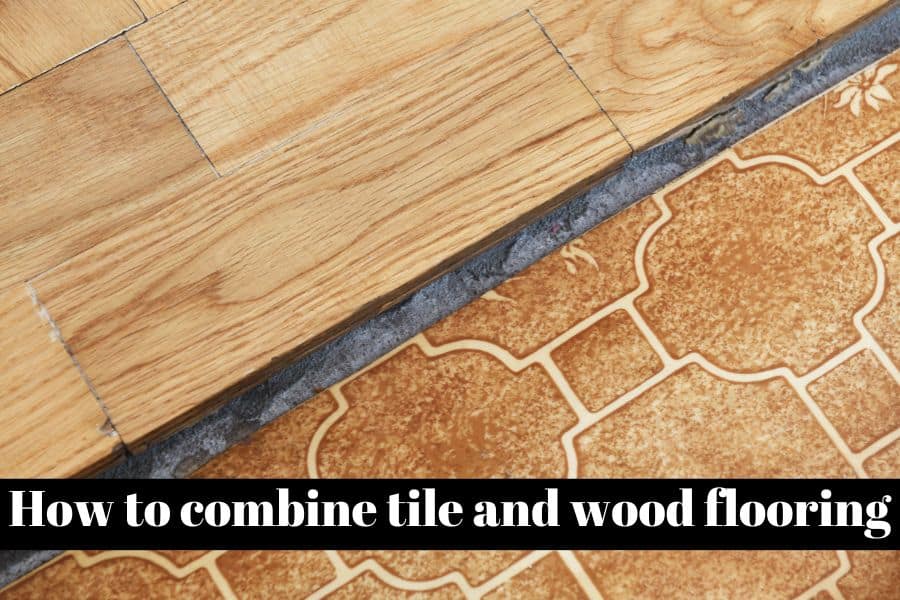
If you’re considering revamping your home’s flooring, combining tile and wood can be a fantastic choice.
It’s not just about the visual impact, although that’s certainly a big part of it.
The beauty of this combination lies in the flexibility it offers for creative designs.
Plus, it’s incredibly practical.
In this article “how to combine tile and wood flooring”, I will cover what you need to think about before you consider mixing flooring types.
I will explain transition ideas that will help you with your project.
Let’s get started…..
Important: On this website, I feature a select number of partners and companies that have products that could help my audience. As an Amazon associate, When you purchase something through my partner links, I might get paid for the referral at no extra cost to you. Read the full disclosure here.
JUMP TO :
Understanding the Basics of Flooring Transition
Factors to Consider Before Combining Tile and Wood Flooring
Transition Ideas and Techniques
Practical Tips for Installation
Understanding the Basics of Flooring Transition
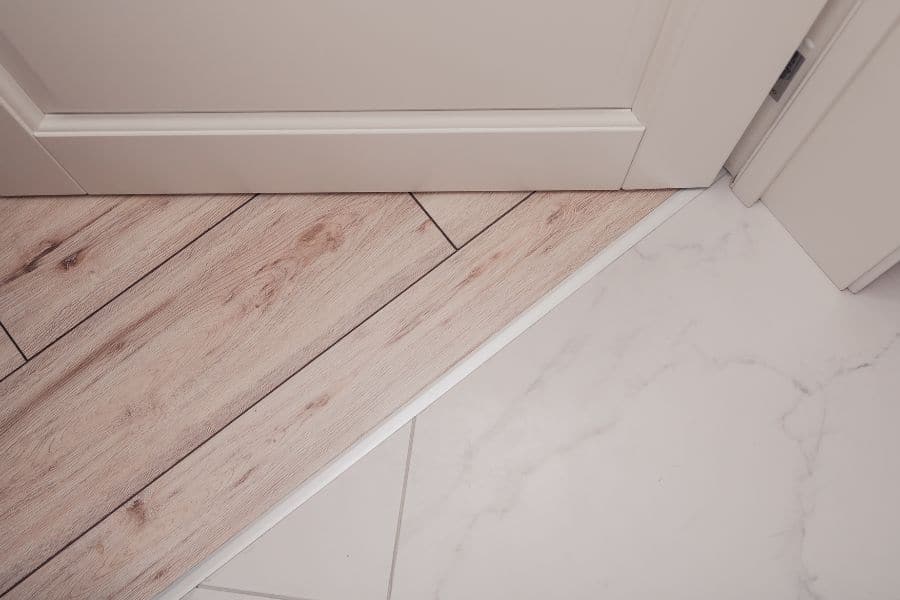
Let’s talk about something cool in home design called flooring transition.
Imagine you have two different types of floors in your house, like a wooden floor in one room and a tile floor in another.
A flooring transition is what you use to smoothly connect these two different floors.
Think of it like a puzzle.
When you have a wood floor transition, it’s like a piece that fits perfectly between a wooden floor and another type of floor.
This piece makes sure there’s no awkward bump or gap where the two floors meet.
It’s called a seamless transition because it helps the floor change from one type to another without any hiccups.
There are different kinds of pieces you can use for this.
A wood transition is made of wood and is used when you want to match with a wooden floor.
But, if you want something more sturdy, you might use a metal transition strip.
It’s a thin piece of metal that does the same job but with a different style.
These transition pieces, whether wood or metal, are important for a couple of reasons.
First, they make the floor safer by getting rid of any uneven spots where you could trip.
Second, they make the floor look better.
Imagine if you had a really cool design on your floor; the right transition piece can make that design look even better.
Floor transition strips are another type you might hear about.

They’re like the helpers that make sure the edges of your floors don’t get damaged or become a tripping hazard.
So, when you’re thinking about floors in a house, remember that it’s not just about picking the prettiest wood or tile.
It’s also about how you connect different types of floors together.
The right transition piece can make a big difference, making your floor not only look awesome but also be safe and last a long time.
And who knows, maybe you’ll come up with a unique look that no one else has!
Factors to Consider Before Combining Tile and Wood Flooring
There are a few things you need to consider first to make sure everything looks just right.
Height Differences
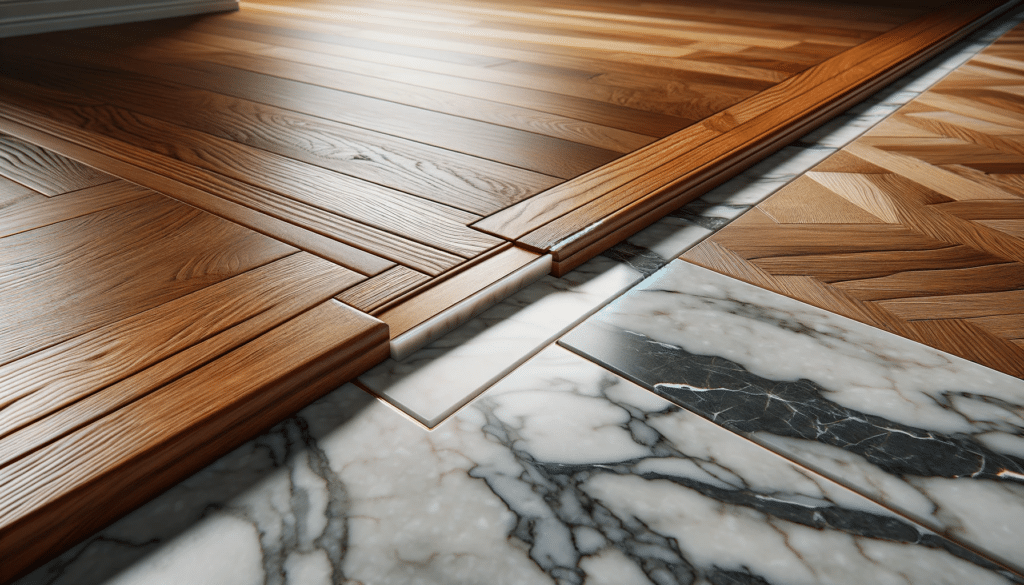
First up, let’s talk about height differences.
Different types of flooring, like tile and wood, often have different thicknesses.
It’s important to assess the height difference between them.
You wouldn’t want to have a step or an uneven surface where they meet, right?
That could be a tripping hazard, and it wouldn’t look too smooth either.
Color Schemes and Patterns
Next, think about the color scheme and different patterns.
The colors and patterns of your tile and wood flooring need to complement each other.
You don’t want them clashing or looking out of place.
For instance, if you have a very vibrant tile, you might want to go for a more neutral wood to balance it out.
Or, if your wood has a very noticeable.grain pattern, choose a simpler tile design.
It’s all about finding a balance that works for your rooms.
Careful planning is key here. You should also consider the different properties of the materials you’re choosing.
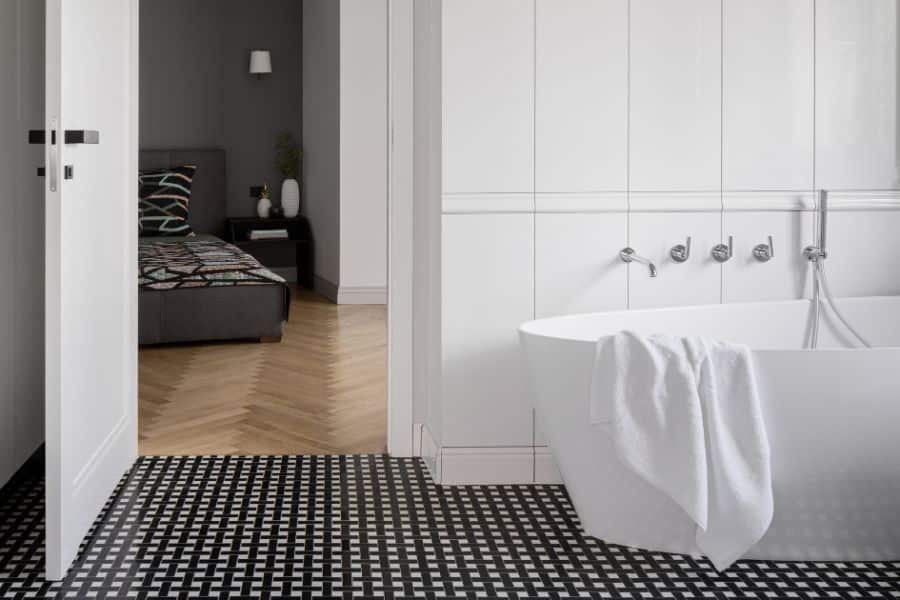
Each type of wood and tile has its own unique characteristics, like durability and texture.
For example, some woods are softer and might not be the best choice for high-traffic areas, while certain tiles might be more resistant to wear and tear.
Also, think about the direction of the wood grains and the tile layout.
This can really affect the overall look of your space.
The direction can lead the eye through the room and even make spaces feel larger or more cohesive.
Let’s not forget about the different rooms in your house.
The type of flooring you choose should be suitable for each room’s function.
Like, wood might be cozy for a bedroom, while tile could be more practical for a kitchen or bathroom.
As your first consideration, really think about what you want each space to feel like. Is it a warm, cozy area or a sleek, modern one?
Your choice of flooring can significantly affect this.
In summary, combining tile and wood flooring is definitely a good idea and can look amazing.
With some careful planning and a bit of creativity, you can create a space that’s both beautiful and functional.
RELATED : GLAZED TILE VS UNGLAZED TILE – WHAT IS THE DIFFERENCE
RELATED : PROS & CONS OF LARGE FORMAT TILES
Transition Ideas and Techniques
Straight Transition
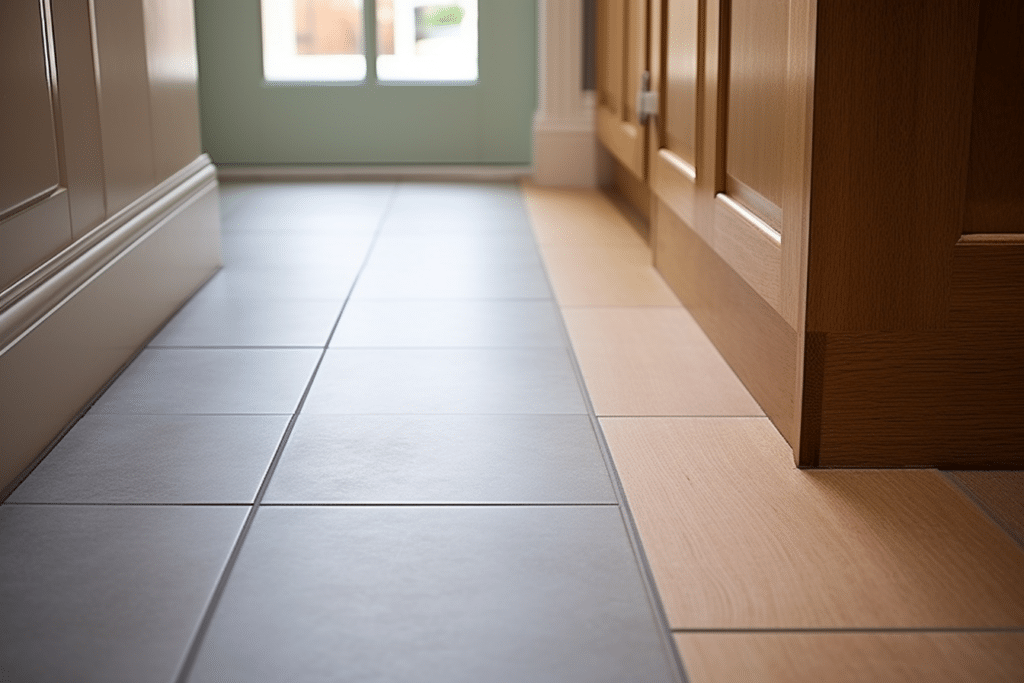
So, for a straight transition, you’re looking at using a simple, straight line to separate the tile and wood flooring.
This is really popular because it gives you a clean and minimalistic look.
You achieve this with a straight line or a straight edge, which keeps the transition smooth and even.
It’s called a flush transition, and it’s all about making the flooring meet neatly without any raised edges. Pretty sleek, right?
T-Shaped Transition Strip

Now, for areas where your tile and wood flooring meet head-on, a T-shaped transition strip is a great choice.
These strips are shaped like the letter ‘T’, hence the name.
When you’re picking these out, consider the types of tiles and the right flooring to match.
It’s about making sure the strip fits perfectly with both the tile and the wood, creating a smooth and cohesive transition.
Mosaic or Patterned Transitions
If you’re feeling creative, how about mosaic or patterned transitions?
You can incorporate mosaic tiles, like glass mosaic tile or stone medallions, to create a really artistic transition.
Hexagonal tiles can also add a neat look.
There are tons of creative ideas here.
This type of transition can become a focal point in your room, adding a lot of character.
Curved Transitions

Okay, curved transitions are super cool for open floor plans.
They create a flowing, natural transition between different flooring types.
Think about using materials like natural stone to add a unique style.
The key here is ensuring a smooth transition, so you’ll need some techniques for cutting and laying tile and wood to fit that curved line. It’s a bit more work, but the result is stunning.
Mixed Media Transition

Last but not least, mixed media transitions are where you blend tile and wood within the same plane.
This isn’t about separating but combining.
You can use faux wood tiles, laminate floors, and even create a unique design.
It’s all about making a perfect combination of tile and wood.
The goal is a seamless integration, so it looks like the two materials were meant to be together.
I like this video on How to transition from tile to wood by Handyman Club
Practical Tips for Installation

Let’s talk about some practical tips for installing your flooring transition.
It’s all about doing it the right way with the right materials to get a beautiful and lasting result.
First things first, preparing the subfloor for the transition is super important.
This is the best way to ensure that your flooring will be stable and last a long time.
You want to make sure the subfloor is clean, level, and ready to support whatever materials you’re going to lay on top of it.
Now, when it comes to tile areas, choosing the right adhesive and grout is important.
This isn’t just about sticking tiles down; it’s about making sure they stay put and look good for years to come.
The right adhesive makes sure your tiles stick properly to the floor without shifting, while the right grout will fill in the gaps neatly and prevent moisture from seeping in.
RELATED : BEST GUIDE TO INSTALL LAMINATE OVER TILE FLOORING
As for cutting and fitting the materials, accuracy is key.
Whether you’re dealing with tile or wood, making precise cuts will ensure that everything fits together perfectly, like pieces of a puzzle.
Tile installation can be a bit tricky, but with careful measurement and the right tools, you can achieve a professional-looking finish.
Remember, the best flooring solution is one that’s installed properly.
So, take your time, plan carefully, and don’t rush the process.
The end result will be worth it, giving you a transition that’s not only functional but also adds to the beauty of your home.
Maintenance and Upkeep
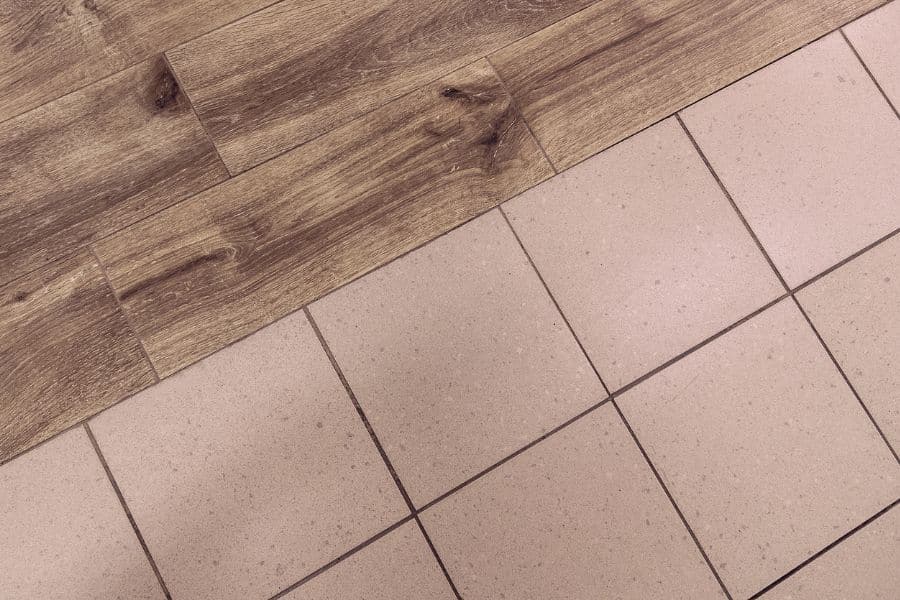
When it comes to maintaining and taking care of your tile and wood flooring, there are a few simple yet effective things you can do.
Regular sweeping is your first line of defense.
It’s a straightforward task but super important.
By sweeping regularly, you remove dirt and grit that can scratch and wear down your floors, especially in those transition areas where tile meets wood.
Now, let’s talk about the durability of tile.
Tile is known for being tough and resilient, making it a wise investment for high-traffic areas.
But even the sturdiest materials need some TLC.
For tile, regular mopping with the right cleaner keeps it looking fresh and new.
Just be careful not to use too much water, especially near the transition points, as excess moisture can affect the wood.

Wood flooring, on the other hand, requires a bit of a different approach.
You’ll want to use products specifically designed for wood floors.
This helps maintain their natural beauty and protects them from wear and tear.
Also, it’s a good idea to quickly clean up any spills to prevent water damage.
Dealing with wear and tear at transition points can be a bit tricky, as these areas are prone to more stress.
An occasional check-up and minor touch-ups can go a long way.
RELATED : HARDWOOD VS TILE IN THE KITCHEN
If you notice any loose pieces or unevenness, addressing these issues sooner rather than later can prevent more extensive repairs down the line.
In summary, a combination of regular sweeping, appropriate cleaning methods, and a little extra attention at transition points will keep your tile and wood floors looking great.
It’s about preserving the beauty and functionality of your investment, ensuring that your floors continue to add charm and character to your home for years to come
Faux wood with hexagon tile

FAQs

How can I create a cohesive look when combining hardwood floors with ceramic tile in a living room?
To achieve a cohesive look, consider the color and texture of both the hardwood and ceramic tile.
Choose tones that complement each other and consider using a similar finish to create a seamless transition between the two flooring materials.
What are some creative ways to use tile inlays with hardwood flooring for added visual interest?
Tile inlays can be used to create unique patterns or borders within hardwood flooring.
This is a great way to add visual interest to a room.
Consider using contrasting colors or textures to make the inlay stand out.
Is wood look tile a good flooring option for dining rooms?
Wood look tile is an excellent choice for dining rooms.
It offers the warmth and natural appeal of wood, while being more durable and easier to maintain, making it ideal for areas prone to spills and stains.
How can I incorporate a herringbone pattern in a flooring design that includes both tile and wood?

A herringbone pattern can be created using either wood or tile, or a combination of both.
This pattern adds a sophisticated and dynamic element to the floor design, and can serve as a transitional area between different flooring types.
What are the advantages of using faux wood tile floors on the lower floor of a home?
Faux wood tile floors are ideal for lower floors as they offer the look of natural wood but are more resistant to moisture and wear.
This makes them a practical option for areas that might experience dampness or heavy foot traffic.
How can square tiles be used effectively in a dining area to complement hardwood floors?
Square tiles can be arranged in various patterns to create an interesting and distinct area within a dining space.
They can be used as a central feature or border, contrasting with the surrounding hardwood to define the dining area.
What is the best way to transition between different materials like tile and existing wood flooring?
The best way to transition between different flooring materials is to use flush transitions with edge-protection profiles or surface strips.
These provide a smooth and safe transition, blending the materials seamlessly.
How can I choose the right kitchen tile to match with natural wood flooring?
When choosing kitchen tile to match with natural wood flooring, consider the color, pattern, and texture of the tile.
Look for tiles that complement or subtly contrast with the natural wood, to create a harmonious look.
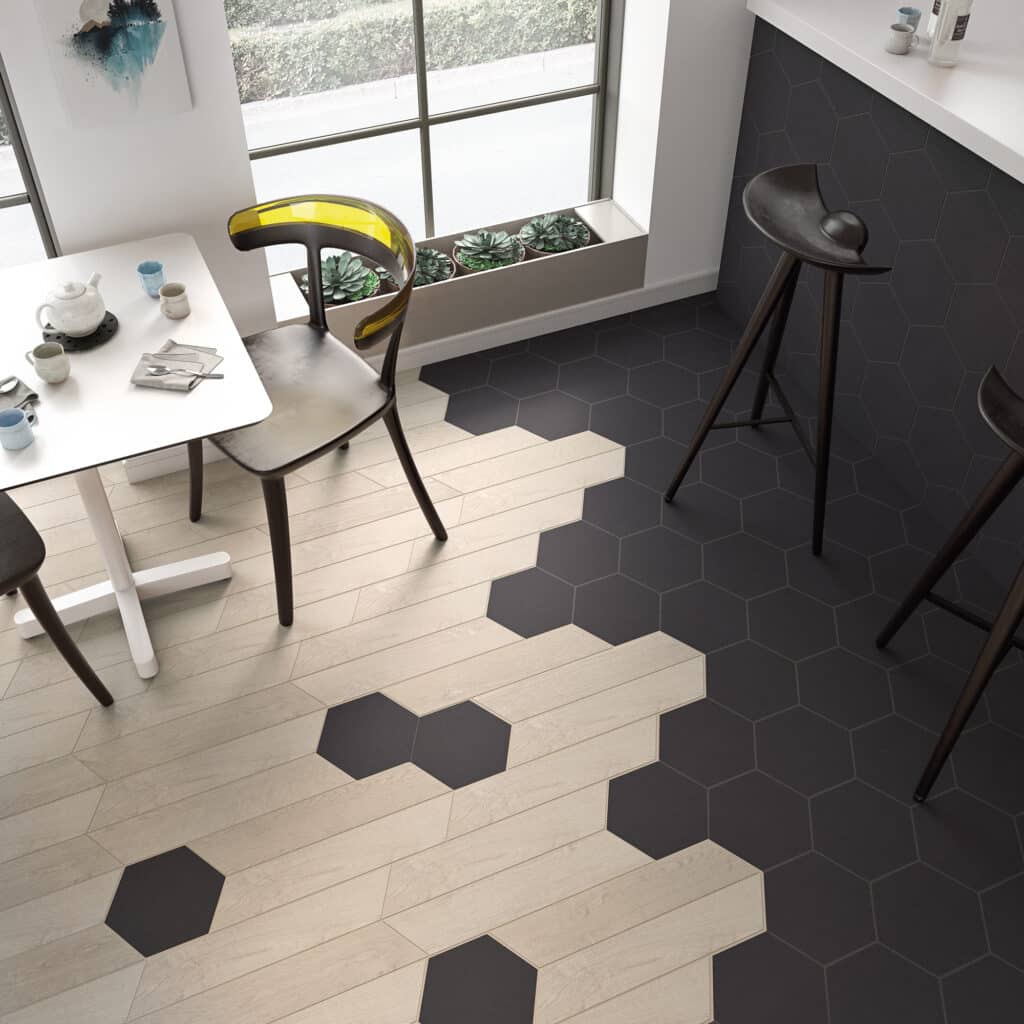
What is the role of an edge-protection profile in creating flush transitions between different flooring types?
An edge-protection profile helps to create flush transitions between different flooring types.
It ensures a smooth, level transition, which is not only aesthetically pleasing but also reduces trip hazards.
Can subway tile be used creatively in transitional floors between wood and tile?
Subway tile can be arranged in various patterns, such as a herringbone or staggered layout, to create a unique transition area between wood and tile flooring.
This adds a modern and artistic touch to the transitional space.
What are some effective solutions for uneven transitions between hardwood and tile floors?
For uneven transitions, transition strips specifically designed to accommodate height differences can be used.
These strips can bridge the gap and level out the transition, ensuring safety and a polished look.
In what ways can stone tiles be integrated with wood flooring for a unique tile floor combination?
Stone tiles can be used as borders, inlays, or in specific areas such as entryways or around fireplaces to complement wood flooring.
The natural texture of stone provides a beautiful contrast to the smoothness of wood, enhancing the interior design.
What are some considerations when installing new flooring in terms of combining various types of flooring?
When installing new flooring, consider the overall aesthetic, the functionality of each space, and how different types of flooring will flow together.
It’s important to think about the transition between different materials and how they will look in the context of the entire house.

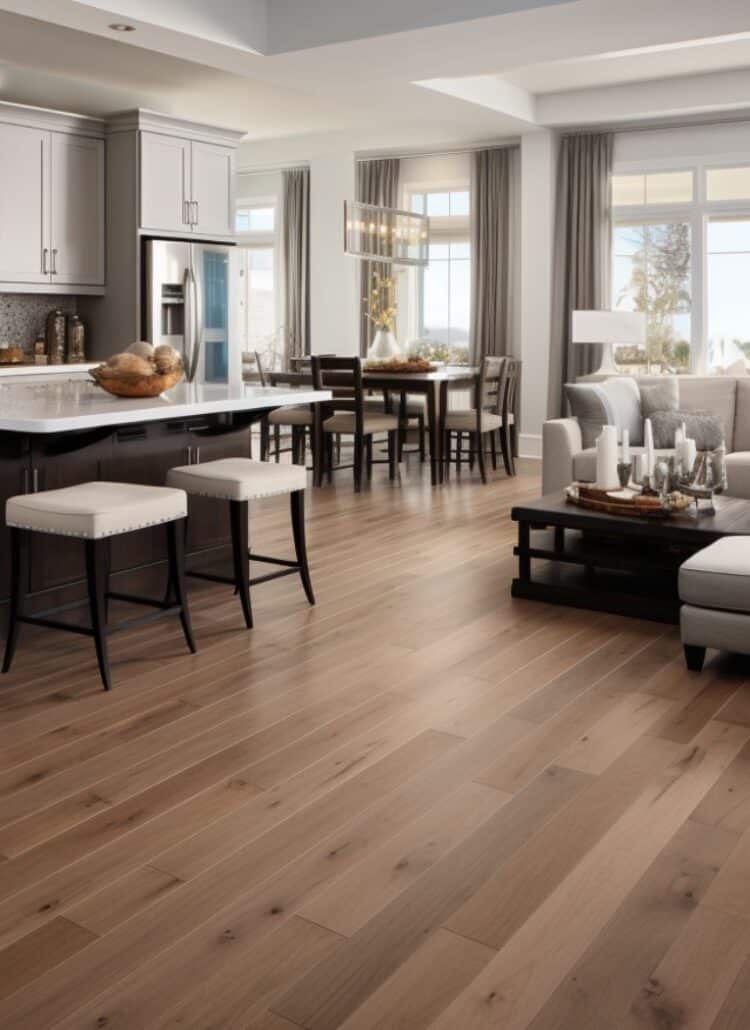

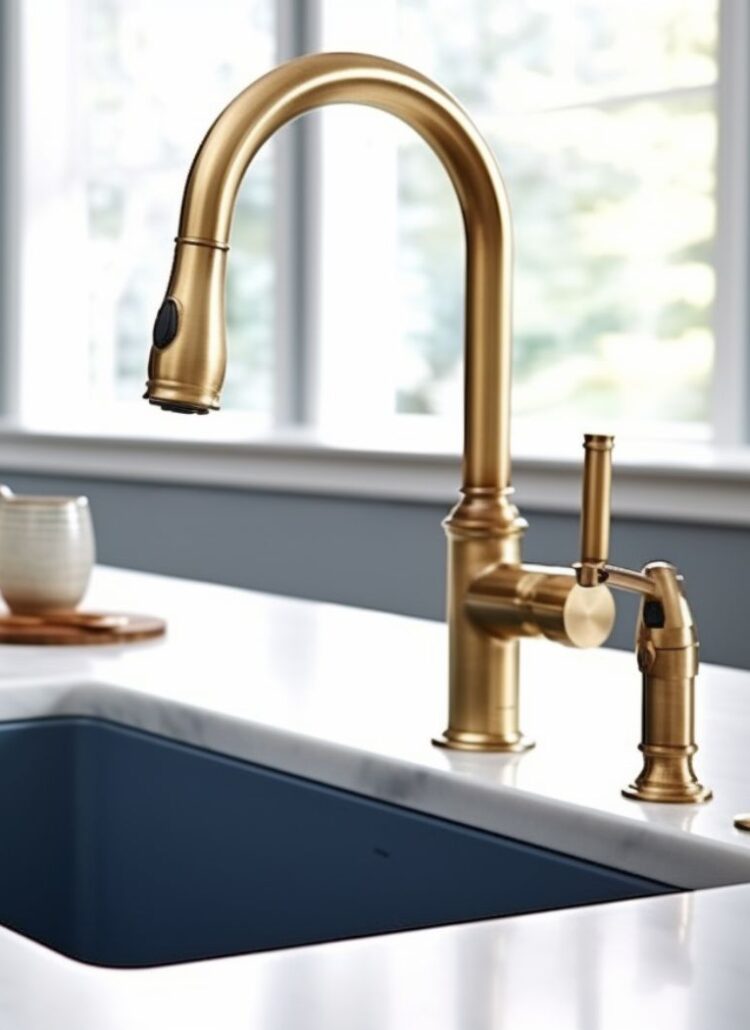


Leave a Reply